Thanks to Andrew Oliver who launched the #video-strategy channel in the PMA Slack Community
I thought it would be a good idea to share a presentation from the Product Marketing Summit which is all about video 📹
The presentation from Vitaly Shter the Senior Director of Product Marketing at Vimeo, looks at how product marketing works at Vimeo, why they love using video and why they believe it is the future of marketing.
Transcript and Slides

"I'm Vitaly. I run Product Marketing at Vimeo. I'm super excited to be here and having great with conversations with all of you. I'm going to talk today about video marketing, which is predictable for a person who works at a video company. It's this CTA, the greatest CTA of all time, that video play button over there. That's what we're going to be talking about today."
"How many people here actually use Vimeo? Wow, that's awesome. Quite a few.
So just as a disclaimer, I've never created a video professionally and never run any production of video. But through my experience of Vimeo and other companies, there are a few lessons and best practices that I'm hoping to pass to you today."
"I'm sure that a lot of you are involved in video creation. Who was involved in video creation in the past? So, hopefully there are some insights here that you can take away from this. Also about the New York video meetup, so if you are in New York City and interested in video, check it out on meetup.com. We're having meetups every two months or so. It's really cool. We bring in video startups, video creative folks who present their work. I encourage you to check it out."
"So, a little bit about Vimeo."
"I came to Vimeo three years ago. There is a video called The Story of Vimeo. It describes how Vimeo is this community of explosive creativity of filmmakers. And when I saw this video about three years ago, that was my 'why' moment for Vimeo. And the reason for that is because Vimeo, unlike any other company that I worked on, at least, is not just a technology company. It's where technology meets creativity or arts and community, the best community of filmmakers around the world. And that was my 'why' moment."
"Since then, I've been at Vimeo, working in product marketing, building the product marketing team. This is not a motivational speech, but I hope that each one of you has the 'why' for yourself. And shameless plug - if your 'why' is similar to what I just described, we're hiring and expanding the team, so reach out to me. I'm not going to have too many shameless plugs in the presentation, but there are a couple. That's the first one."
"Vimeo is not just a place where you go to see these really creative, awesome, adorably weird films. It's also a place where people use the tools to either drive their production or drive their marketing. And we launched recently, maybe some of you have seen that recent campaign across the country, that Vimeo can help assist with your video campaign. The point there was to point out that Vimeo is not just a video destination for awesome videos. But we also have actual tools that help you do your work. This is the top message. Vimeo can help, but can also be followed up with middle of the funnel messages around specific tools and features we have. And I'll mention some of them throughout the presentation."
"With that, let me spend two minutes before talking about video marketing and [instead] talk about what product marketing is at Vimeo. I found very useful when other folks yesterday presented their take on product marketing. It's a little different in every company. So for us, we spoke yesterday about inbound product marketing and outbound product marketing. "
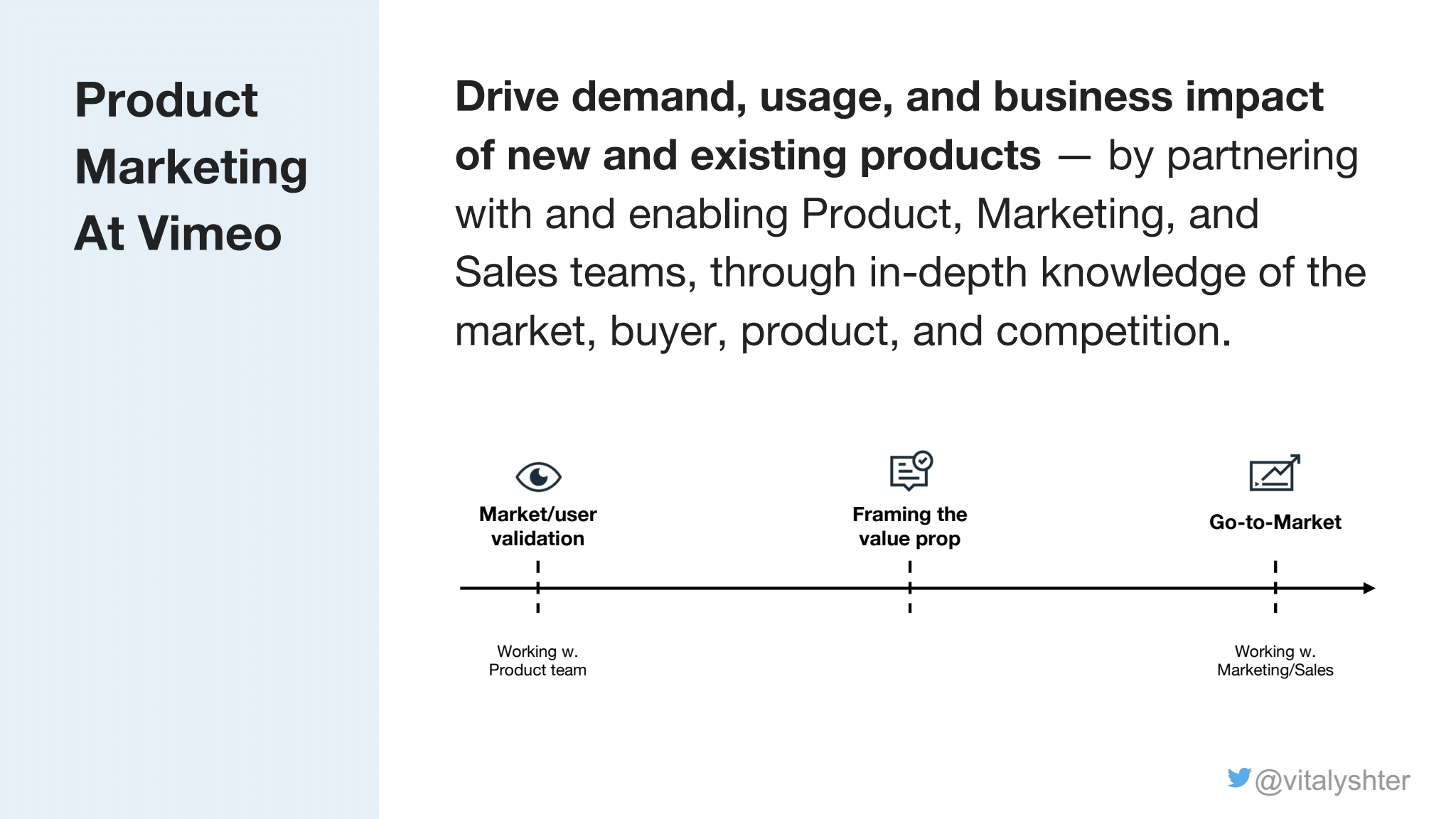
"We work on inbound marketing with the Product team. Basically, looking at the market, assessing the needs and understanding the user. And then with the marketing team, we create the go-to-market strategy and the different campaigns that go into that."
"We are the team that drives demand, usage and business impact of new and existing products. And that goes hand in hand with the product team, the marketing team and the sales team. What's unique to product marketing is that we're the most knowledgable in the company on everything that comes to the user, the competition, the products as it pertains to the user and competition. So, there's some conversation around how Product Marketing and product teams overlap but don't overlap in some areas. There's always going to be a tricky area, because you have to be a little bit sensitive around how other teams are perceiving [you].
So, we define very clear areas where there's design and overlap between a team and different areas that are uniquely owned by product marketing or a product team."

"The overlap areas are market validation, user research, looking at what markets are regarding to and assessing them It's the strategic and business case that we're presenting to leadership when we're approaching new markets, or expanding existing ones, and then the whole idea of growth, whether it's user onboarding or driving adoption in various ways. Although, we do have a separate growth team that's responsible for the growth across the entire websites or the entire offering. "
"The growth that product marketing and product teams are responsible for is specific to products. So, things like onboarding and driving adoption for features. And then it's pretty standard in terms of the things that product marketing actually owns uniquely. The messaging positioning, the pricing and tearing and then the whole go-to-market launch and competitive analysis. So that's product marketing at Vimeo."
"I'm sure you've seen enough quotes to understand and to know that video is integral to what we do as Marketers/Product marketers. I'm only going to have three quotes here."

"The most interesting one I thought is from Ryan Halligan, the HubSpot CEO. He is basically saying that you need to be looking more into hiring video people than copywriters, or blog writers. Because video just has better ROI than text. Now, I don't fully agree with that because the two have to live together. Video makes your blogs and other content more effective. But, the point is that video is the most engaging medium today. So, companies, if you have not invested in it yet, video has become a priority for you."
"Who does video? Well, plenty of companies like the brands that you see here, they all use Vimeo."
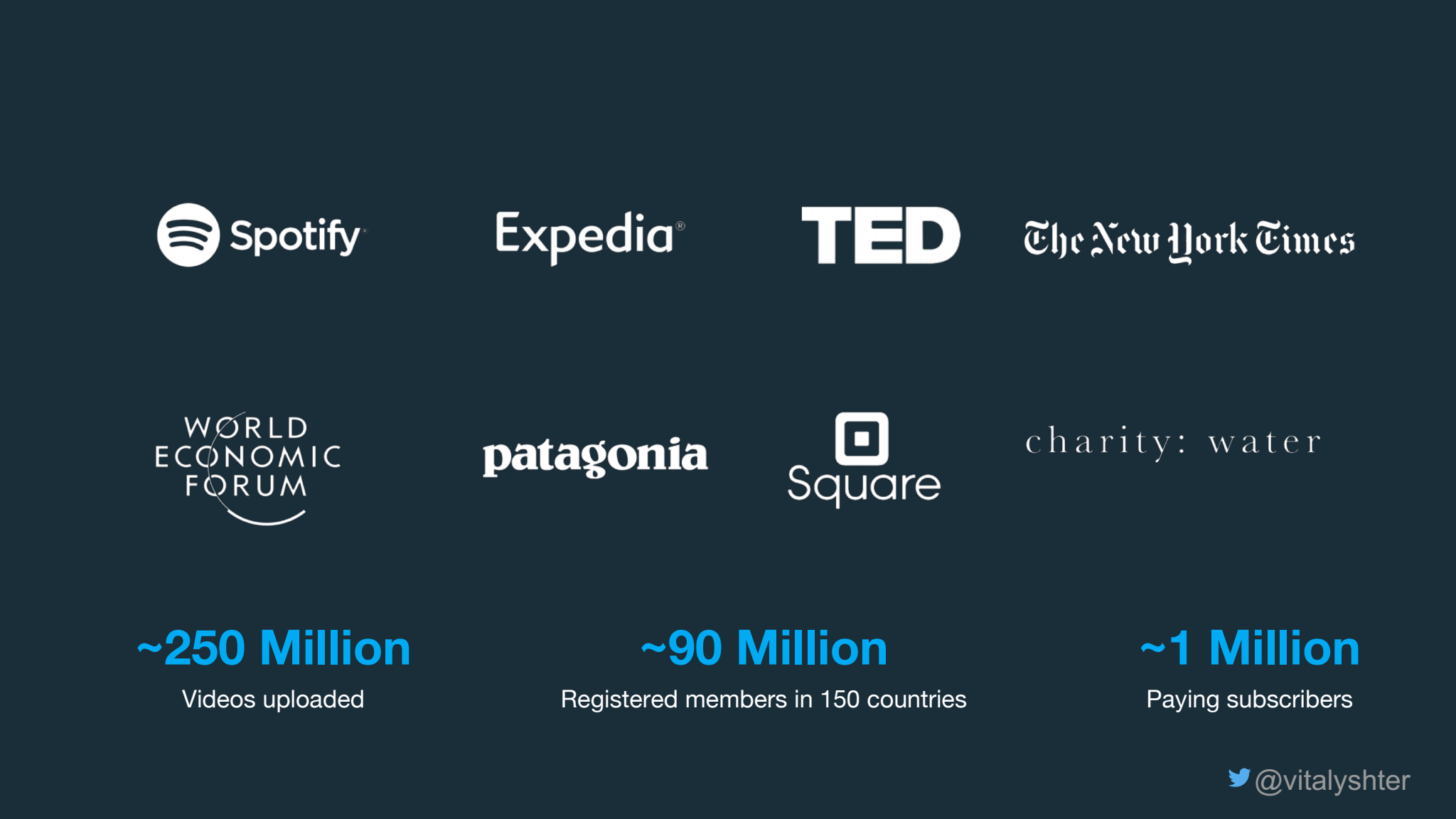
"And, many of you folks here in the room seems like you use Vimeo as well.
But a lot of these companies have great budgets, they've been through trial and error of creating videos. They got the lessons, they got big teams, both internally and external agencies. But what about the long-tail? The smaller businesses? Or marketers at companies that are working on specific things that are not too well connected with the production team or different startups? How do those people approach video and specifically video marketing. And for me, working for a video company in a marketing role, I feel like I have this unique vantage point of seeing how the art of storytelling is colliding with the science of marketing. And that's essentially what video marketing is to me."
"So, as you're thinking through your video marketing strategy, I would bucket the things you have to think about into these main areas."
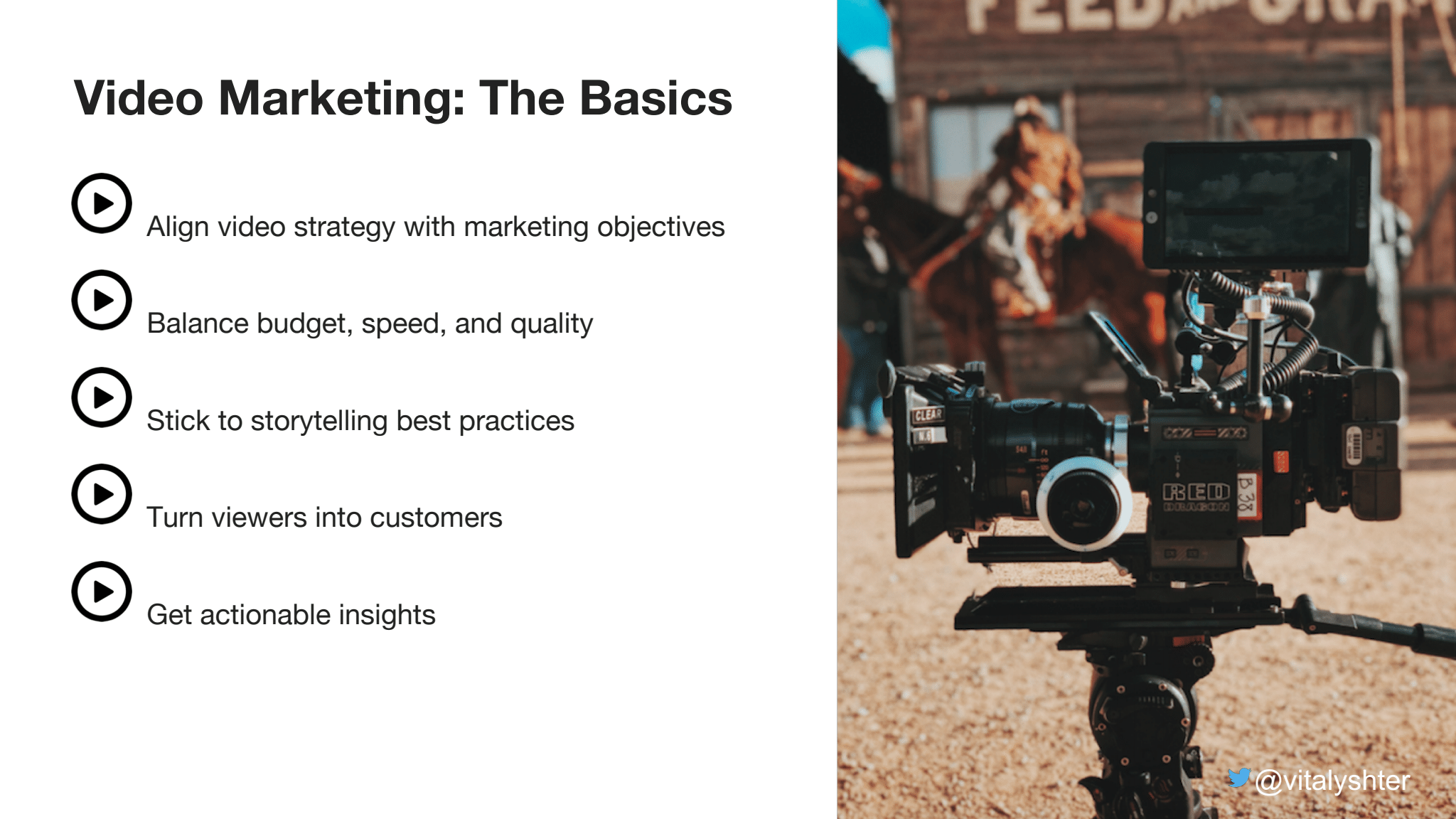
"Number one is aligning your video strategy with your general marketing goals. You don't want to be that person who's at a meeting and says 'Let's make a video.' That's not a strategy. The strategy is how to use that video more holistically with the other marketing activities that you do to drive specific goals."
"The second thing is creating the almost impossible balance between budget, speed and quality when it comes to creating video. It's almost impossible to reach that sweet spot. You're always going to sacrifice either speed or the quality or the budget when it comes to that. So we're going to talk more about this."
"And then there's specific storytelling best practices that everyone who has been creating video for the past few decades already knows about. So, it's important to keep those in mind as you decide what videos to create. What purpose do they have, and what kind of storytelling should you use in those videos?"
Next, is the marketing within video marketing. How do you use that video holistically? Where's the video going to live? How's it going to drive action? How's it gonna drive results for you? And speaking of results, how are you getting actionable insight in terms of how you're going to measure the impact of the video you created, and what can you learn next. So, I'm going to dive into each of those areas real quick."
"The first one is aligning your video creation with your marketing objectives."

"I'm sure you've all seen plenty of marketing funnels. I'm sorry you have to see another one. But video, in that sense, is not very different than other content you created, especially in B2B which I think most of you are. And that's because when you create a video, it has to live in a specific part of the funnel for a specific goal. If your goal is to drive awareness and position your brand, then the type of videos you're going to be creating are social, snackable entertaining content. Educational content. Things that you can teach your target audience about. An area that's important to them. Not selling your product yet, of course, that's the top of the funnel. And then of course, ads that could be more focused on brand or specific product areas"
Most of you as Product Marketers are probably not working on videos in the top of the funnel, that's usually the content team or the brand team. Although from conversations with some of you, it sounds like you do work on some of those videos. When those brand campaigns or content are including things like product features, and product capabilities, you're the person who's telling the agency or the content or the creative team how to position those features in that brand campaign. Middle of the funnel is where Product Marketers start to be a lot more active."
"That's where we create product videos,'explainer' videos about your offering, case studies, webinars, which could be gated and non-gated. And again, as with most consideration/decision funnel phases, the goal is to deepen the trust with your users to educate them about your offering, and generate demand and leads."
"Then the bottom of the funnel is after someone becomes a customer already or user, how do you use whatever videos you need to create, to make them use your product more.? To retain them and to grow a share of wallet. So, the videos you create there are 'how to', onboarding videos, different best practices."
"One thing to keep in mind. Video is not just a produced video, it's also live"
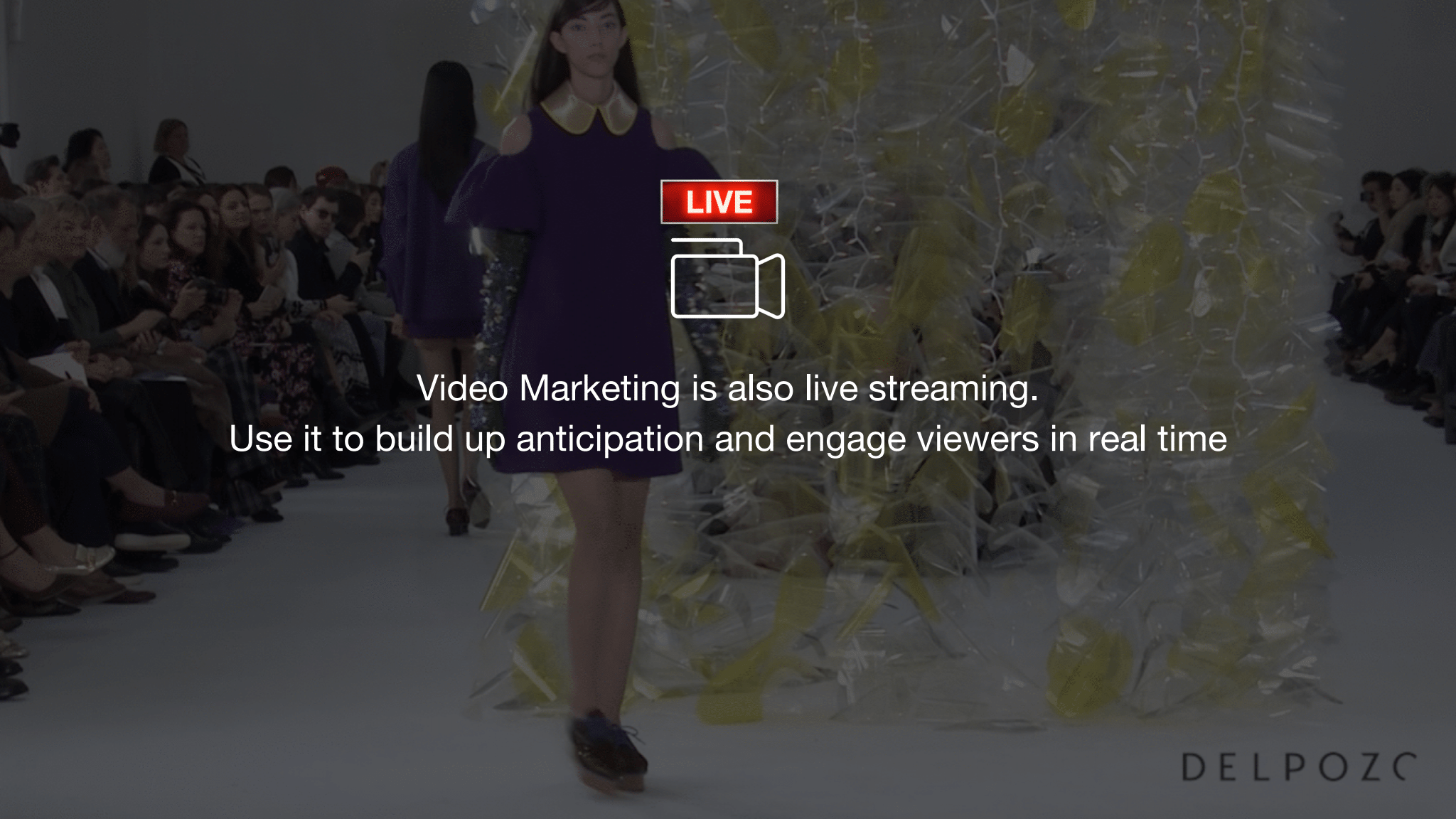
"Facebook, YouTube and LinkedIn are looking into launching live soon. This has become a true medium of communicating your marketing message, whether it's through webinars or best practices. And the reason to use live streaming is to build up anticipation for a specific event and also to have a lot more of an engaging conversation with your audience in real time."
"Let's talk about the almost impossible balance between budget speed and quality."

"Like I said, you can only get two or three. You can get budget and speed but maybe not quality. You can get quality, but not speed. Something has to give. So, depending on your goals and the type of videos you're creating, you have to decide, what are you actually sacrificing?"
"Then, a bunch of questions come to mind when you think about balancing and creating your videos. So, the questions usually come up as, 'Should I produce the video in house if you have a production team? Or, 'Should I export it to outsource it to an agency?' 'Are there any shortcuts/any new technologies that might help me create videos or help me scale my video production much faster?' 'How much should I spend on a video?' This point is always very important."
"Also, 'How long should the video be?' Depending on the type of video you're creating, that actually drives a lot of the decision-making around where this video lives and how much you spend on it. Then finally, if you're creating a video, how do you make it not a one off project but actually an evergreen ongoing initiative?"
"Let me start with the shortcuts."
"Here are three examples of shortcuts to lower the barrier of production."
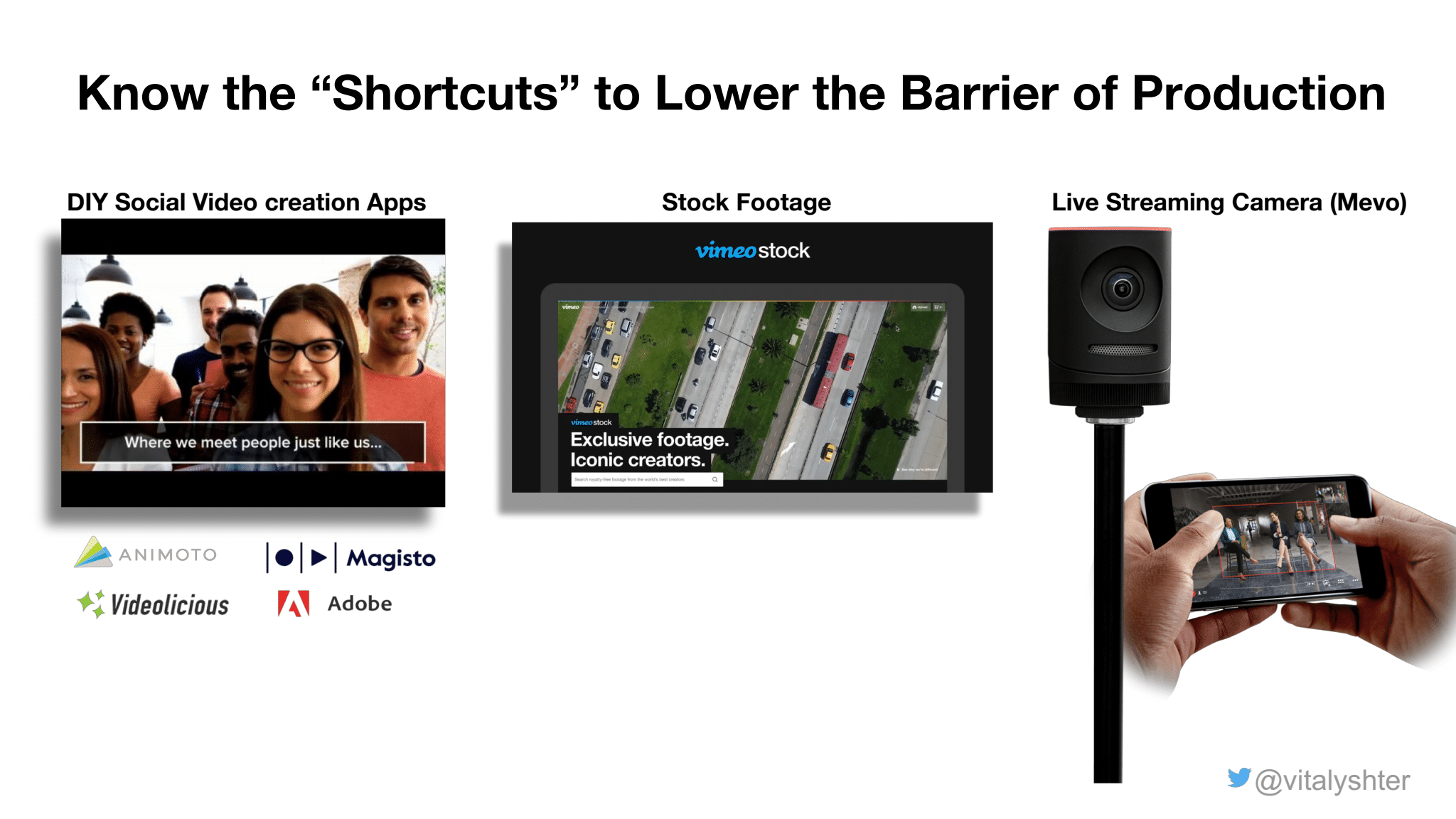
"So, one is if you are doing a live event. There's another shameless plug - this is a live streaming camera by Vimeo. It's called Mevo. It's a full on production packed in a palm size device. [It's] a camera that's operated with your mobile device. That allows you to have, not full scale professional grade live events, but definitely quality live streaming, with all the effects that you will expect from a live production, including zooming in and lower thirds. So, if you're looking into producing live events, and you're looking to start small, this is a great shortcut for you, [because] you will not need a full live production team."
"The second thing I want to talk about is stock footage. Has anyone here used stock footage or knows what it is? A few of you. Stock footage is essentially a shortcut when you're working on a specific project and you don't have that specific shot of a blue eyed Labrador walking down the street in Chicago. You would go to a stock offering and you'll be able to find something similar to that. What that allows you to do is really scale production and cut down on time that it takes to create a video. Because, you don't need to produce all the content anymore, you have it ready. So Vimeo Stock is an offering that you can use for that."
"And the third one is what I call, 'Do It Yourself' social video creation. These Apps are becoming pretty popular. What these allow you to do is, as a marketer, or someone who doesn't have background in production, [is] very easily create a video that you could potentially use in your social media. So, companies that do that are Animoto, Magisto, Videolicious [and] Adobe has a the product for that."
"So these are your shortcuts. Now, when you don't do shortcuts, this is what the consideration could potentially look like. "

"Now, it's not an exact science. But what I've found is that the type of video you create is closely tied to the stage of the funnel the video is in. Whether it's pre-sale or post-sale, that's tied to whether you should be looking at an agency or in-house production. So for example, in the pre-sale stage, most people will be looking at agency, some in-house production. In a post sale stage, you'll probably either use a simple 'Do It Yourself' tool like I just showed you, or use an in-house production.
So, as you go up the funnel, the length of the video increases. The ads are very short, the snackable content is very short. And, as you go towards thought leadership and webinars, more down the funnel, that's where content becomes a lot longer. So, this is pretty straightforward in terms of comparing production agency versus in-house as a 'Do it Yourself' tool to production."
"When you outsource it to an agency, it's going to take longer, the budget is going to be much bigger, but the quality is going to be something you wouldn't be able to produce in-house because agencies do have skill sets and best practices they can use towards the video. For an in-house team, depending on specific skill sets that you have and the size of your production team, it's going to take a shorter period of time because there's less back and forth. It's not going to cost as much - it's your internal team. But you still need some budget for them to create these videos. The quality is going to be good. Not potentially as amazing as outsourcing."
"Then as you're thinking about general costs of an average video, depending on the constraints and quality, it will cost you anywhere between $3000 for the lower end, and then $15,000 for something a little bit more sophisticated. And, when it gets to creating polished ads, that's $60,000 and up. You need to compare that as you're thinking about your video strategy. Do you want to continue to outsource videos versus having an internal production team? Compare that against a typical salary of a production team. If you are the person who's responsible in making those decisions, it's something to keep in mind."
As you're thinking about the video creation, what's very important, and I'm sure, as some of you have done this process before, is to think through who's responsible for what through the entire stage.

"Initially when you're creating the concept or the script, if it's a product video, the script is a very simple, two column narration, [acccompanied by] the visual aspect of it. It's as simple as that. But, Product Marketers for the most part is going to be responsible for that script if it's a product video, for example. As you get to the pre-production, production and post-production stage, there's not much you need to do as a Marketer or Product marketer, but you do need to be in the loop to make sure that your vision is in the video. Because it's very easy for the Creative Director to go rogue and be like, 'oh, I added this awesome flashy thing over here,' and it's completely off in terms of what you had in mind. So that's where review and approval really comes in very handy."
"You need to set milestones where you will be approving, and then reviewing things and providing feedback to the creative team. And then finally, when it comes to distribution and tracking of success of the video, you need to be working with the performance marketing team to make sure that the product is distributed correctly, in the channels that you want, for the type of users that you want to see that video. And that everything is set up correctly to track success for the video."
"To the point of providing feedback. This is a tool (another shameless plug) that Vimeo has. It easily provides feedback directly in the video to make sure you don't have to do the whole long email thread saying, 'here in five minutes, 37 seconds, you'lll need to fix this and the top left corner.' So, instead of that, it just does this."
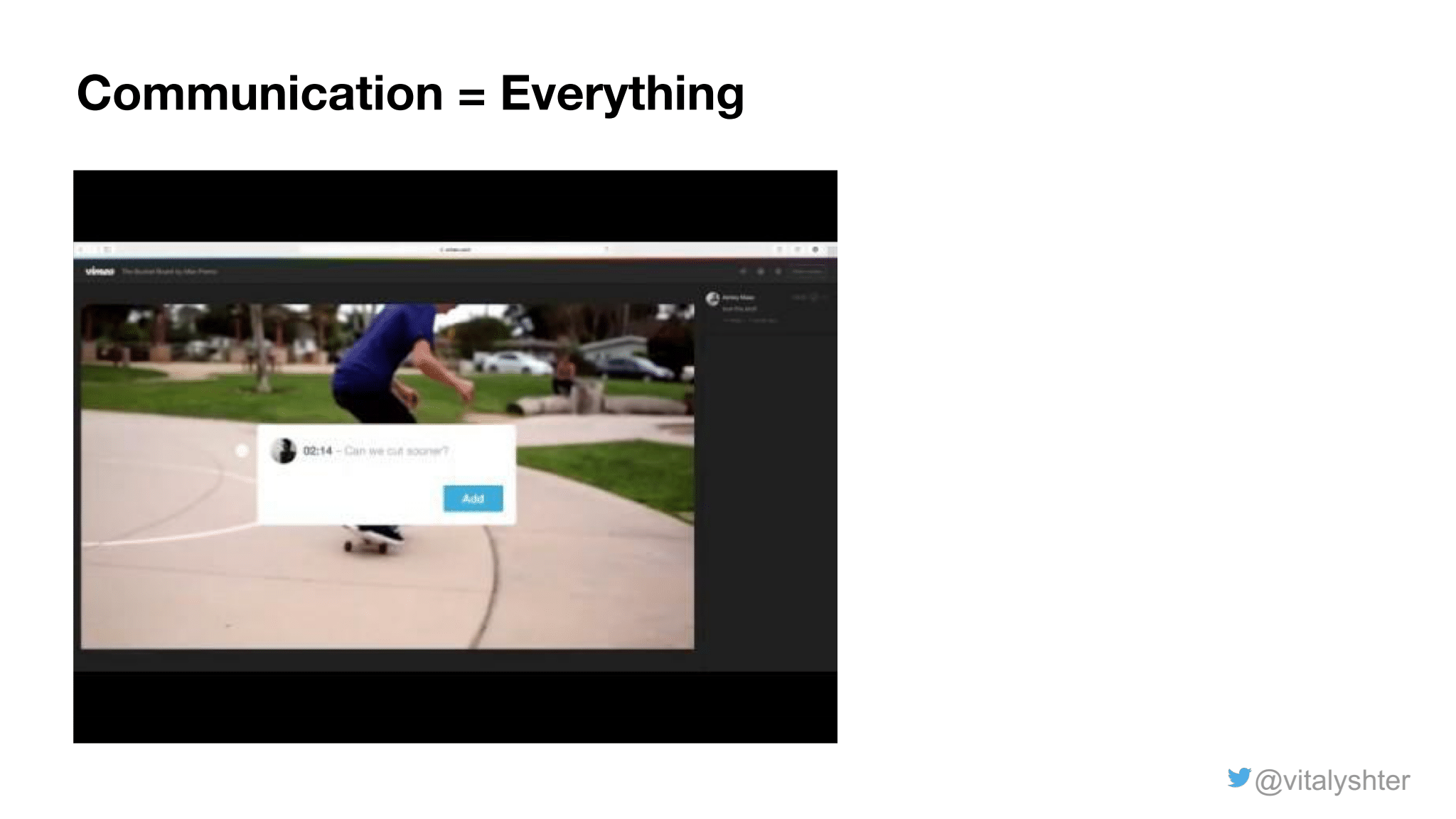
"Point, write a comment. And the editor will then see it over here. As soon as you go along, the editor will start resolving your comments. And then hopefully, by the end, all your comments are resolved. And that for me, at least, saves hours of time."
"Storytelling and best practices?"

"[Think of] humanizing your brand and with employee faces and customer stories. A quick example of a coffee shop in Brooklyn, they actually created a series where they talk to people who come to the coffee shop. And they're really talking about their stories. What are they doing with their lives. It's been driving a lot of engagement for this coffee shop. And it's very authentic, very cinematic. It has been working."
"Teach what you know, so again, establishing yourself as an expert in the space is something that you would do you would use video for. For example, if Vimeo is a video platform, we have something called Vimeo Video School, where we teach about anything from how to pick your camera equipment, to how to distribute your content. Vimeo is not a camera company. But, we know that it's important to the type of user so we create videos about that. Authenticity often goes a much longer way than having a super polished video. Then visual consistency with your brand. Wherever the video lives, it needs to look like everything around it. It's part of the campaign. It's part of the landing page, or if it's in an email or in social, it's very important to have this visual consistency for the video. And the last one is using emotion to humanize and drive action. Happiness, sadness, all these emotions drive specific call to actions."
"So, you've created the videos. What do you do with them? How do you actually drive action?"
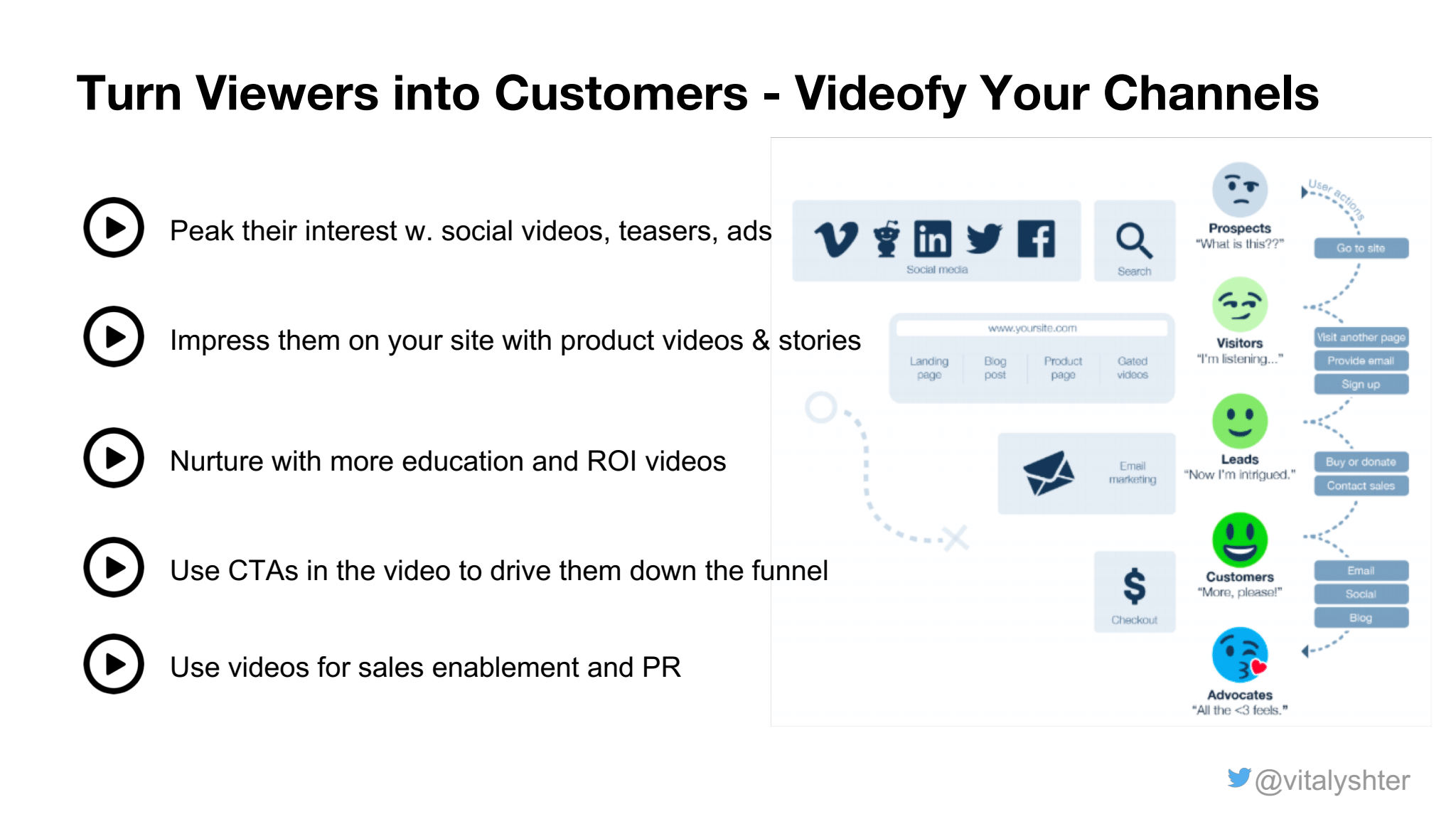
"It comes down to 'videofying' your entire funnel or all your channels. From having videos on your social, depending on what type of video you're creating and what type of goal. To driving people from social to your website with a specific call to actions, and then converting them on your websites to leads and opportunities. Nurturing those users with video, and then finally delighting them as users. So, keep in mind what are those call to actions you have in each stage and what type of videos you use in each area."
"Speaking of social videos, Vimeo has a tool that we call Publish to Social. Essentially, it allows you to easily distribute videos with a single click, to multiple social destinations, Facebook, YouTube, LinkedIn, and Twitter."

"It's basically simplifying your workflow. The fact that you can also track all the analytics from the social networks in a single place, it simplifies your life as a Marketer."
"Finally, all of it is not worth it if you can't get actionable insights. You have to track what's the actual impact. So, things like engagements, how long people are watching the video.
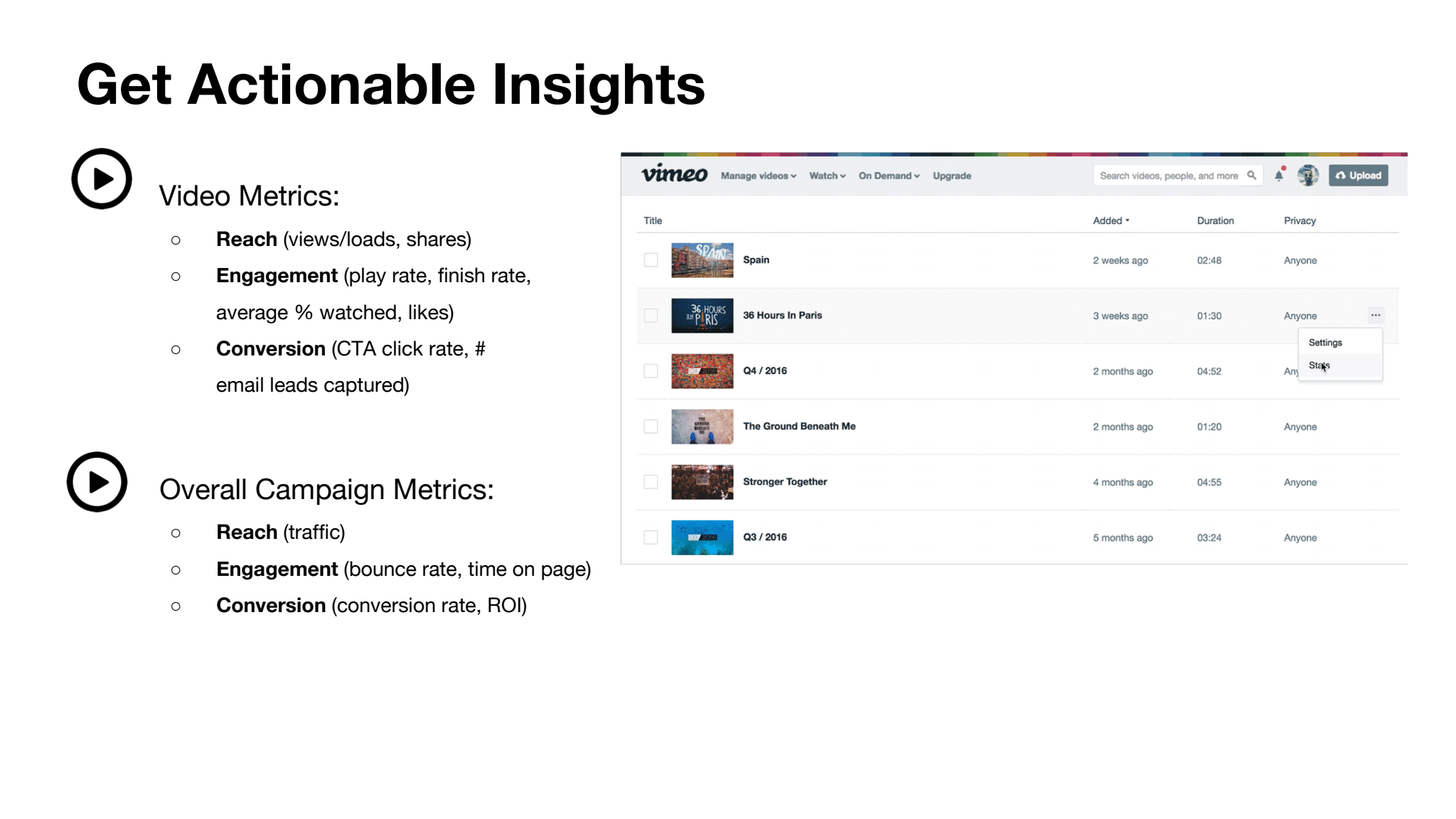
"If I can see that there is a big drop of within in 30 seconds I'll know that next time I'm creating a video or maybe even modifying this specific video, how can I fix that, to make the video much more effective? So, tracking everything that's not just views, but beyond. "Engagement. How does this video help to convert viewers into customers? That's critical."
"To sum it all up. Make great content often and strategically. get people to see it and actually care to take action. And the action is really important here - what's your call to action in the video? Where does the video live? And then the video works, but how do you prove that it works? Use analytics. Very important. Finally, check out any business. Shameless plug - I'm hiring. And come to the next video meetup. That's me."

"Any questions for Vitaly?"
[Question] "Your very last bullet point on the slide, which was, 'make sure it works and measure success beyond views and plays.' Could you just speak to that really quickly? How do you measure success beyond views and plays? That's something we've struggled with. If there's not really a clear call to action within the video. The video itself has nothing to do other than just to watch it. So, how do you make sure it's driving conversion? How do you measure that?"
"It depends what you want to measure. So, one way to measure is what I described. Where in the video are you starting to lose people. So, that helps you to improve the video and video strategy later on. Besides that, Vimeo has integration with Google Analytics. So, you'll be able to track how video performs within the overall Google Analytics campaign. You can connect. For example, if you have a video on the landing page, the traffic that comes to this landing page is because you have video there and you have clicks. And and people are watching the video for a certain amount of time. How does it help in converting that traffic? You would normally want to do some kind of A/B, to have a couple of versions of video, or perhaps have one landing page with video or without video. I know it's harder to do that with or without video because you want the landing page to work. But these are the kind of techniques we use."
[Question] "In the map of the production process, you had product marketing stepping out during pre-production. And, I guess having done some video work myself, I would find that a little bit dangerous to let go and maybe I'm just a control freak. But, I would worry that things would spiral and go away from brand, go away from core messaging in that process. I don't know if you have any thoughts on that."
"Yeah, totally. I've been a victim of that. We stepped out a little bit too much, and the video at the end turned out to be not great. That was $100,000 investment that didn't pan out the way we want it. So, it is dangerous. You do you need to be involved through post-production for sure with the review. Pre-production, it's to the degree that you're providing an input on the concept and on the script. The pre-production here is more the technical aspects of getting ready for the shoot, getting the cameras, insurance, things like that. Those are not product market responsibilities. But, the script, the concept, making sure it all fits with the general message you want to communicate in the brand. That's totally product marketing."
[Question] "For customer testimonial videos, how prescriptive do you recommend being with the script and how long ideally should they be?"
Unfortunately, the answer is that it depends. It's how are you going to be using those customer testimonials and what kind of testimonial will they provide? Do you want them to provide testimonial about specific features in the product? Because you will be using it in the middle of the funnel. Then, the video is going to be longer and you'll probably have, while they're talking, some footage from within the product. So, those videos will can be between 60 to 90 seconds. For testimonials that are not super product oriented, but more 'This is the value we drove.' Those can be shorter and more inspirational in nature. So I would say, it depends if it's just a single customer or maybe a soundbite of numerous customers talking about the same topic, but those can be between 30 and 60 seconds. And then we've done quite a few webinars where we bring a customer to talk about how they use video, and the specific product. Those are 15 to 30 minutes webinars. So it really depends what kind of customer testimonial it is."
[Question]"Coming from a B2B tech space, our challenge is deciding from the awareness stage, what what type of videos we actually utilize. Whether it's product focused videos, or humanized videos. What type of videos do you find are a little bit more engaging when it comes to those two top of the funnel stages."
"So, again, it really depends on the goal that you're trying to achieve. You have to look at the the lead. Where did they come from? What did they see before that? Automate their process. For the most part, people watching product videos are aware of the product. They're aware of the problem that it solves. But, 'How do you guys solve it and how are you better than competitors in that space?' So this is kind of what we try to focus on when we create product videos in the middle of the funnel, but general awareness and customer testimonials are also very helpful there."

